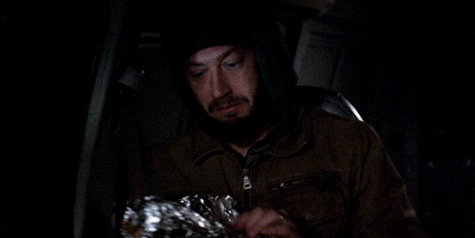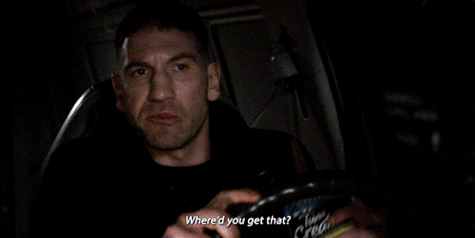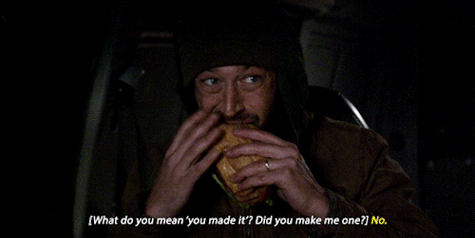
Hello, and welcome back to my look at the first Marvel/Netflix spinoff, The Punisher, which continues the story of the Jon Bernthal-played title character who was introduced in the second season of Daredevil. Last time, we kicked things off with a look at Episodes 1-4. This time, we'll complete the first half of the show with an examination of Episode 5: “Gunner”; Episode 6: “The Judas Goat”; and Episode 7: “Crosshairs.” I'll use my perspective and knowledge as a longtime Marvel Comics fan and journalist to evaluate the quality of the episodes, compare the characters and events to the source material that inspired them, and offer up any Easter eggs you may have missed.
So let's get started! Keep your head down, and if we get separated, I'll meet you at the extraction point!
In Episode 5, the Punisher and his friend, reporter Karen Page (Deborah Ann Woll), have a heart-to-heart conversation where Karen expresses how she thinks everyone is lonely and that life is often a battle to not be alone. This conversation really encapsulates the theme of loneliness that echoes through this series so far.

And loneliness is certainly a huge part of the central relationship between Frank Castle (Jon Bernthal) and his computer hacker ally, David Lieberman, aka Micro (Ebon Moss-Bachrach). In the early episodes, living alone caused Frank to routinely battle against his grief and PTSD. When Lieberman reached out to him—and after a thorough vetting process—he provided not only a friend but a purpose.
That purpose becomes all the more clear in Episode 6 in a truly touching scene where Frank talks to Lieberman's wife, Sarah. He tells Sarah that it’s important to have something to deal with the loneliness and give her purpose—and for her, it's her kids. We get a sense that Frank’s purpose is now to reunite the Lieberman family and destroy the military conspiracy that murdered his wife and children.
The theme of loneliness is also explored in these episodes in powerful and horrific fashion with PTSD-suffering soldier Lewis Wilson. He thinks he's found a kindred spirit in O'Connor to help him deal with the trauma from which he's suffering, but his friend turns out to be a fraud. This pushes Lewis over the edge, and he explodes and heads down a dark path of murder and probably worse, as he appears to be constructing an IED in the final scene of Episode 7.

Incidentally, Lewis Wilson is also the name of an organized crime figure that appeared in several 1969 Spider-Man comics, but that character is so different from the one that appears in The Punisher that I think it's just coincidence they share the same name.
The attention to relationships—Lewis and O'Connor, Frank and Micro, and others—in the first half of The Punisher is what makes this show outstanding. Sure, there are several great moments of action, but that's sort of the icing on the cake. The real highlight of the episodes are the poignant, powerful, and sometimes even humorous relationships between the characters. And because we care about these characters, the action scenes resonate more and crackle with palpable tension.
I especially love the way the relationship between the Punisher and Micro develops in these episodes. They've gone from reluctant allies to a perfect Odd Couple-style friendship. The scenes where they’re talking in the van or having dinner together while they discuss tactics or their pasts are especially entertaining.





While the Punisher and Micro begin to trust each other, Castle's relationship with his old best friend, Billy Russo, becomes much more complicated. As viewers, we know that Russo is part of the conspiracy that killed Frank's family—but Frank does not. Longtime comic fans of the Punisher were not surprised by Russo's treachery because his comic counterpart is Frank Castle's greatest foe, Jigsaw. But I'm curious as to how this played to someone who did not know the significance of the name Billy Russo.
The reveal that Russo is rotten still worked for me, however, because of the way Ben Barnes plays the character. He comes off quite slimy, but he's also effective in making you think Russo genuinely cares about people. I'm quite curious to learn more about his backstory, what caused him to turn bad, and how he ultimately feels about Frank.
Of course, I'm also excited for the Punisher and Billy to ultimately square off face-to-face this season—especially if it leads to Russo being transformed into Jigsaw. I’m assuming that will happen at the end of the series and Russo will return next season as Jigsaw.

Another boss-subordinate relationship developed in these episodes between Homeland Security Agents Dinah Madani and Sam Stein. They are fast becoming friends, and I like that Dinah is allowed to be the emotionally distant jerk, whereas Sam is the more open one. It's a nice reversal of the usual way that relationship is portrayed, and I enoy that—at least for now—their relationship is not a romantic one.

There weren't a whole lot of comic book Easter eggs in this batch of episodes. The only real big one that stood out for me was the fact that Frank and Micro employed a van for their operations. In the comics, the Punisher's signature ride is his Battle Van—an armored assault vehicle equipped with all sorts of special gadgets added by the comic version of Micro. It's basically the Aston Martin to his James Bond. The Netflix van appears to be just a standard one, which is fine and fits with the more grounded feel of the show, but I wouldn't be surprised if it showed off some unique features in future episodes.

One particular comic trapping I'm sort of missing is Punisher's signature death's head shirt/armored vest. It made sense for him not to wear it in these initial episodes since his enemies did not yet know he was alive. But now that they know Castle is alive, and he's aware they know, it makes sense for Frank to break out the death's head again. It's intimidating and gives him a psychological advantage. Plus, it serves a practical purpose in that it leads enemies to subconsciously shoot at the death's head target on Frank's chest (which is almost certainly covered in kevlar) rather than his head. So hopefully we'll see the iconic Punisher skull again soon.
Ultimately, Episodes 5-7 of Netflix's Punisher once again delivers a solid block of episodes by focusing on characters first and action second but also upping the ante and escalating things with each episode. The real question will be: can it keep that level of quality for the back half, which is traditionally the weakest part of Netflix's 13-episode Marvel shows?
I'm off to find out the answer to that question! Join me back here next Wednesday for my penultimate installment of this feature where I'll tackle episodes 8-10.
| The Punisher navigation | ||
| The Punisher, Episodes 1-4 | The Punisher, Episodes 8-10 | |
Dave Richards covers all things Marvel Comics for the Eisner Award-winning website Comic Book Resources and his book reviews and other musings can be found at his blog Pop Culture Vulture.

In January 1952, Elizabeth, then 25, set off with Philip for an overseas tour. The King, against medical advice, went to the airport to see the couple off. It was to be the last time Elizabeth would see her father.